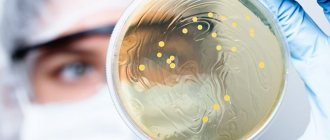Each person normally secretes mucus in the lumen of the bronchi. This mucus protects the bronchi and lungs from dust and infection from the inhaled air. If a person is healthy, then the production of this mucus is not accompanied by a cough. However, when inflammation occurs in the bronchial tree, there is a significant increase in mucus production and a change in its viscosity. A cough occurs and the person coughs up this mucus. Mucous discharge passes through the bronchi, trachea, laryngeal cavity and mouth before leaving our body. This discharge is called sputum. Sputum is also called discharge during inflammatory processes in the upper respiratory tract - nasopharynx, larynx.
The nature of sputum - its color, viscosity, smell - has important diagnostic significance. In classical medicine, there are such artistic descriptions - sputum in the form of “raspberry jelly” (suggests the presence of pneumonia caused by Klebsiella pneumonia). Or canary-colored sputum (may indicate pulmonary aspergillosis). Scarlet sputum may indicate hemoptysis or pulmonary embolism.
For chronic and acute pulmonary diseases, mucopurulent and purulent sputum is most characteristic. The sputum becomes cloudy and yellow instead of clear. Over time, the color of the sputum becomes yellow-green, and later takes on a purulent, green character. Sometimes the sputum has a putrid odor. The physical properties of sputum also change - it becomes viscous and viscous. It is difficult to cough up.
What diseases cause purulent sputum?
Purulent sputum when coughing can appear for various reasons. Mostly this is caused by serious problems in the body, so you should not treat the symptom yourself. Why does a purulent cough appear:
- pneumonia;
- disturbances in lung function;
- bronchitis;
- tuberculosis;
- asthma;
- tumor.
A healthy person may expectorate a small amount of mucus per day. Normally it is transparent and odorless. Depending on its color, sputum indicates the presence of certain diseases. For an accurate diagnosis, you need to see a doctor and undergo the necessary tests. What does yellow-green sputum indicate:
- allergy;
- pneumonia;
- untreated flu;
- asthma;
- bronchitis;
- pharyngitis;
- lung abscess.
Sputum that is rusty, red, or brown:
- pulmonary edema;
- tuberculosis;
- pneumonia;
- lungs' cancer.
A cough with white sputum indicates the presence of a fungal infection or tuberculosis. It is important to remember that self-medication is contraindicated when coughing with purulent sputum. You should immediately seek help from a doctor.
- Cough with sputum - how to treat in adults and children
Possible complications
Ignoring the symptoms of minor hemoptysis can lead to the development of massive bleeding.
It causes the airways to fill with blood, which blocks access to air. As a result, death from asphyxia (suffocation) may occur. Death is also possible with heavy blood loss, amounting to about 4–4.5% of the total body weight. If left untreated, the disease that caused hemoptysis continues to progress and cause complications. With cancer, metastases appear, with pneumonia and tuberculosis - fibrosis of the lung tissue, with bronchiectasis - bleeding, abscess, infarction and necrosis of the lung.
Treatment methods
To begin treatment of cough and its root cause, the patient first needs to undergo the necessary tests. It can be:
- radiography;
- blood and urine tests;
- sputum analysis;
- bronchoscopy;
- spirography.
The doctor also conducts a visual examination and only then prescribes medications to improve expectoration of mucus. In addition to them they use:
- Physiotherapeutic procedures;
- Therapeutic gymnastics;
- Acupuncture;
- Immunomodulators;
- Massage;
- Surgical intervention.
Medicines used to treat this symptom are divided into the following categories:
- antibiotics;
- antiviral drugs;
- mucolytics;
- bronchodilators;
- anti-inflammatory drugs;
- homeopathic medicines;
- complex medicines.
The patient should drink frequently and a lot, give up smoking and alcohol, walk and breathe fresh air every day, and eat right.
Oral diseases
The appearance of an unpleasant rotten or rotten odor, both with and without a cough, may indicate oral diseases or insufficient hygiene. Irregular brushing of teeth leads to the appearance of plaque on them, as well as rotting food particles that remain in the small crevices of the oral cavity even several hours after eating. The unpleasant odor from the mouth becomes especially pronounced after sleep.
Other causes of odor include the following oral diseases:
- Stomatitis,
- Caries,
- Gingivitis,
- Tartar, formed from plaque due to insufficient oral hygiene,
- Gum abscess,
- Periodontal disease.
Pathologies of the oral cavity often become causes of disruption of the gastrointestinal tract. This is possible because, passing through diseased teeth, food carries some pathogenic microorganisms into the stomach.
- How to treat a dry cough in an adult that lasts for a long time without fever
ENT pathology
Almost all ENT diseases arise as a result of exposure to pathogenic microorganisms on the mucous membrane. These can be either viral or bacterial, most often coccal, infections. When they infect the human mucosa, they actively multiply in it. The result of the vital activity of pathogenic microflora is the appearance of purulent inflammation.
The main ENT diseases that provoke the appearance of cough with an unpleasant odor and pus are:
- Sinusitis. Pus accumulates in the maxillary sinuses and remains there constantly,
- Tonsillitis. It is characterized by inflammation of the tonsils and the appearance on their surface of accumulations of pus, consisting of dead bacteria, dead epithelial cells and leukocytes.
The appearance of small, foul-smelling lumps when coughing most often indicates tonsillitis. With sinusitis, pus is most often excreted in sputum.
Diabetes
The appearance of a cough with a specific odor from the oral cavity is also possible with diabetes. In this case, the cough itself occurs due to constant dry mouth that accompanies the pathology, and the foul odor is a reaction to dehydration.
In diabetes mellitus, cough may be accompanied by the aroma and taste of acetone. This phenomenon occurs when the mucous membranes are dry due to fasting or lack of fluids, especially with excessive sweating.
Diseases of the gastrointestinal tract
A foul odor, as well as a cough, can occur in a person due to slow digestion, low acidity of gastric juice, and also due to rotavirus infection. The smell of rotten eggs occurs when coughing and belching due to fermentation and rotting of undigested food. Coughing in such cases is often accompanied by the flying out of small lumps of rotting food. The pathology may also be accompanied by vomiting.
Sour belching and a cough with a sour smell may indicate gastritis or a peptic ulcer of the stomach or duodenum.
Top 5 Causes of Bad Breath
Frequent communications with other people are an integral part of modern life. While bad breath can cause “forced silence.” How to avoid becoming an introvert against your will? And where to look for the cause of the trouble?
1. Insufficient hygiene and dental diseases
Food debris on teeth and gums provides food for oral bacteria. And the “waste” of such a diet becomes volatile compounds (ammonia, hydrogen sulfide and others), a large concentration of which is felt as an unpleasant odor.
In addition, such conditions contribute to the proliferation of pathogenic flora, which:
- firstly, it disrupts the pH of the oral cavity (due to bacterial waste products) and promotes demineralization of enamel and tooth tissue itself;
- and secondly, it increases the concentration of volatile substances in the oral cavity and contributes to the appearance of an unpleasant odor.
Thus, both improper hygiene and excess bacteria and signs of inflammation in gum disease, even with good hygiene, may be to blame for the appearance of a “problematic” odor.
In the first case, normal hygiene procedures twice a day, as well as rinsing after meals during the day, are sufficient to eliminate the problem. And in the second, the solution obviously requires the participation of a dentist.
Dry oral mucosa
This phenomenon often occurs while taking certain medications and is caused by insufficient saliva production.
In this case, the cleansing properties of saliva practically disappear, which contributes to the “accumulation” of food debris in the oral cavity and their “decomposition”, and also significantly “makes life easier” for bacteria.
Chronic diseases of the respiratory system
Chronic tonsillitis, pharyngitis, and sinusitis are a reliable source of excessive growth of bacteria in the oral cavity. Here we are most often talking about staphylococci and streptococci, which have pronounced pathogenic properties.
An unpleasant odor can also appear with purulent diseases of the bronchi and lungs, as well as with tumors at the stage of destruction. In this case, the smell from the mouth often becomes putrid in nature, and the cough is accompanied by copious sputum production.
Digestive system diseases
“Stomach” odors are often sour (with normal and high acidity) or “rotten” in nature (with low acidity), and appear under the following conditions:
- reflux of stomach contents back into the esophagus (reflux),
- narrowing of the gastric outlet (pyloric stenosis),
- the presence of ulcerative and oncological processes in the stomach or duodenum.
The smell can also be associated with liver damage, and then it has a characteristic “liver” tint.
Severe metabolic disorders
We are talking primarily about diabetes mellitus and its severe complication – ketoacidosis. The smell from the mouth in which case resembles “acetone”, and the condition itself can be fatal.
How to find the reason
1. You can confirm the “microbial” origin of bad breath by inoculating a swab from the throat and nose. The study will not only “show” the quantity and quality of microorganisms, but will also allow you to select an effective antibacterial drug, if necessary.
Culture is also relevant for sputum, if it is separated.
And also, in any case, an examination by a dentist and an ENT doctor is recommended.
2. It is quite difficult to check the condition of the stomach and duodenum using laboratory methods, therefore, if a “gastric” origin of the odor is suspected, a consultation with a gastroenterologist and FGDS is recommended.
3. The liver is one of the most multifunctional organs, so it is not surprising that many people experience its damage at a young age.
You can check the digestive function of the organ using a blood test for liver enzymes (ALT, AST), bilirubin, alkaline phosphatase and gamma-GT, both individually and in the format of the Liver Examination complex. Base".
4. A blood test for glucose levels and glycated hemoglobin (average level over the last 3 months) is “meant” to control the risk of diabetes.
Antibiotics for coughs with purulent sputum
If a doctor has prescribed antibiotics to a patient, the entire course must be taken. Do not change the dose or duration, even if there is an improvement in the condition. Take antibiotics in tablet form or intravenously. Only in fairly complex cases, the doctor may prescribe several types of antibiotics. What medications are prescribed:
- What you can do for a cough while breastfeeding: syrups, lozenges, tablets
- Trifamox;
- Amoxiclav;
- Clindamycin.
Each drug acts on different bacteria. Therefore, before prescribing a course, you need to conduct an analysis of the bacterial flora. When coughing with purulent sputum, you need drugs with a strong effect. You should not take antibiotics very often. Bacteria become accustomed to them, which reduces their effectiveness. Also, these medications have a number of side effects and contraindications. It is advisable to take them with probiotics - drugs that normalize the functioning of the intestinal microflora.
What is phlegm needed for?
Sputum is the secretion of the tracheobronchial tree separated by expectoration mixed with saliva. Its purpose is to remove dust and microbes from the bronchi that enter the body when inhaled. Additionally, this mucus contains immune cells that help fight germs.
Inside, the bronchi are covered with epithelium with cilia, which, when moving, help clear the airways of mucus. In a healthy body, the amount of sputum produced is approximately 100 ml per day. In this case, it is swallowed unnoticed by the person and does not lead to any unpleasant sensations. If pathological processes occur in the body, then the amount of mucus produced sometimes increases to 1500 ml per day. Moreover, each disease is accompanied by sputum of a certain color.
Where can I buy










